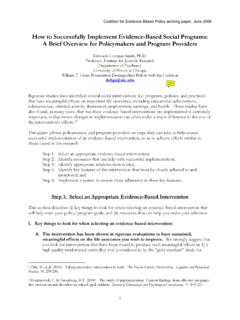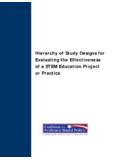Transcription of Which Comparison-Group (“Quasi-Experimental”) Study ...
1 Which Comparison-Group ( quasi - experimental ) Study Designs Are Most Likely to Produce Valid Estimates of a Program's Impact?: A Brief Overview and Sample Review Form Updated January 2014. This publication was produced by the Coalition for Evidence-Based Policy, with funding support from the William T. Grant Foundation and Department of Labor. This publication is in the public domain. Authorization to reproduce it in whole or in part for educational purposes is granted. We welcome comments and suggestions on this document Brief Overview: Which Comparison-Group ( quasi - experimental ) Studies Are Most Likely to Produce Valid Estimates of a Program's Impact?
2 I. A number of careful investigations have been carried out to address this question. Specifically, a number of careful design-replication studies have been carried out in education, employment/training, welfare, and other policy areas to examine whether and under what circumstances non- experimental Comparison-Group methods can replicate the results of well- conducted randomized controlled trials. These studies test Comparison-Group methods against randomized methods as follows. For a particular program being evaluated, they first compare program participants' outcomes to those of a randomly-assigned control group , in order to estimate the program's impact in a large, well- implemented randomized design widely recognized as the most reliable, unbiased method of assessing program impact.
3 The studies then compare the same program participants with a comparison group selected through methods other than randomization, in order to estimate the program's impact in a Comparison-Group design. The studies can thereby determine whether the Comparison-Group estimates replicate the benchmark estimates from the randomized design. These design-replication studies have been carried out by a number of leading researchers over the past 20 years, and have tested a diverse range of non- experimental Comparison-Group designs. II. Three excellent systematic reviews have been conducted of this design-replication literature; they reached largely similar conclusions, summarized as follows.
4 The reviews are Bloom, Michalopoulous, and Hill (2005) 1; Glazerman, Levy, and Myers (2003) 2; and Cook, Shadish, and Wong (2008) 3; their main findings include: A. If the program and comparison groups differ markedly in demographics, ability/skills, or behavioral characteristics, the Study is unlikely to produce valid results. Such studies often produce erroneous conclusions regarding both the size and direction of the program's impact. This is true even when statistical methods such as propensity score matching and regression adjustment are used to equate the two groups.
5 In other words, if the two groups differ in key characteristics before such statistical methods are applied, applying these methods is unlikely to rescue the Study design and generate valid results. As Cook, Shadish, and Wong (2008) observe, the above finding indicts much of current causal [ evaluation ] practice in the social sciences, where studies often use program and comparison groups that have large differences, and researchers put their effort into causal modeling and statistical analyses that have unclear links to the real world.. B. The Comparison-Group designs most likely to produce valid results contain all of the following elements: 1.
6 The program and comparison groups are highly similar in observable pre-program characteristics, including: Demographics ( , age, sex, ethnicity, education, employment, earnings). 1. Pre-program measures of the outcome the program seeks to improve. For example, in an evaluation of a program to prevent recidivism among offenders being released from prison, the offenders in the two groups should be equivalent in their pre-program criminal activity, such as number of arrests, convictions, and severity of offenses. Geographic location ( , both are from the same area of the same city).
7 2. Outcome data are collected in the same way for both groups , the same survey administered at the same point in time to both groups;. 3. Program and comparison group members are likely to be similar in motivation , because the Study uses an eligibility cutoff to form the two groups. Cutoff-based studies also called regression-discontinuity studies are an example of a comparison - group design in Which the two groups are likely to have similar motivation. In such studies, the program group is comprised of persons just above the threshold for program eligibility, and the comparison group is comprised of persons just below ( , families earning $19,000.)
8 Per year versus families earning $21,000, in an employment program whose eligibility cutoff is $20,000). Because program participation is not determined by self-selection, and the two groups are very similar in their eligibility score, there is reason to believe they are also similar in motivation. By contrast, many other Comparison-Group designs use a program group comprised of persons who volunteer for the program, and a comparison group comprised of non- volunteers. In such studies, the two groups are unlikely to be similar in motivation, as the act of volunteering signals a degree of motivation to improve ( Which could then lead to superior outcomes for the program group even if the program is ineffective).
9 4. Statistical methods are used to adjust for any minor pre-program differences between the two groups methods such as propensity score matching, regression adjustment, and/or difference in differences. Although such methods are highly useful in improving a Study 's impact estimates, no one method performed consistently better than the others across the various design-replication studies. C. The three reviews reach varying conclusions about whether Comparison-Group studies meeting the preferred conditions above can consistently produce valid results, replicating the results of large, well-conducted randomized controlled trials.
10 Consistent with Cook, Shadish, and Wong (2008), we believe additional design-replication studies, testing the most promising Comparison-Group designs against benchmark randomized controlled trials, are needed to convincingly answer that What is clear, however, is that meeting the preferred conditions above greatly increases the Study 's likelihood of producing valid results. D. Subsequent design-replication evidence has strengthened the case for cutoff-based Comparison-Group designs as a valid alternative when a randomized trial is not feasible. Such designs are described above (under 3).









